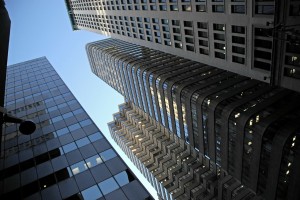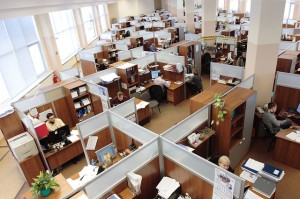 The office concept has been around since organized civilizations have been in existence and has been through many evolutions over history to fit the needs of the times. The word office stems from the Latin officium. An officium was not necessarily a place, but rather a mobile work space. Taking a walk through history we see some of the broad changes in the office environment that have occurred from early civilizations to the most recent trends for office space.
The office concept has been around since organized civilizations have been in existence and has been through many evolutions over history to fit the needs of the times. The word office stems from the Latin officium. An officium was not necessarily a place, but rather a mobile work space. Taking a walk through history we see some of the broad changes in the office environment that have occurred from early civilizations to the most recent trends for office space.
- The High Middle Ages (1000–1300) saw the rise of the medieval chancery, which was usually the place, or office, where most government letters were written and where laws were copied. The rooms of the chancery often had walls full of pigeonholes, constructed to hold rolled up pieces of parchment for safekeeping or ready reference; a precursor to the book shelf.
- The Industrial Revolution (18th and 19th century) saw the rise of banking, railroads, insurance, retailing, oil, and the telegraph industries. To transact business, an increasingly large number of clerks were needed. Most of the desks of the era were top heavy with paper storage bins extending above the desk-work area, giving the appearance of a cubicle and offering the workers some degree of privacy.
- The Midpoint of the 20th Century, brought to light that an efficient office required discretion in the control of privacy. In 1964, the Herman Miller (office equipment) company engaged Robert Propst, a prolific industrial designer, who came up with the concept of the Action Office which later evolved into the cubicle office furniture system.
Advancements in technology and the economy have changed the need for  commercial office space. The Recession of 2008 has caused companies throughout the country to re-evaluate their real estate needs and reduce space requirements. The emerging trend in office space design of smaller, open workstations with more collaborative shared space allows formerly obsolete buildings to be re-designed into contemporary office space.
commercial office space. The Recession of 2008 has caused companies throughout the country to re-evaluate their real estate needs and reduce space requirements. The emerging trend in office space design of smaller, open workstations with more collaborative shared space allows formerly obsolete buildings to be re-designed into contemporary office space.
Here are some of the newest trends in commercial office space planning:
- Reducing Space: Tenants are reducing their office space needs by using less space for each employee. The recent economic downturn has prompted businesses large and small to re-evaluate their real estate needs. For many companies, their office space lease expenses are second only to salaries in total annual costs. The need or desire to cut expenses has led office tenants to look for flexibility in office space, with an overall goal of reducing the amount of space per employee.
- Functional Layout: Office space design and layouts are dramatically shifting. Over the past few years, the look of the typical office space has been changing. The standard, high-wall office cube for a single employee, laid out in rows across the floor, is being replaced by smaller workstations with lower wall separators, or none at all. This open space has become more valuable as technological advances in communication devices and Internet connectivity now allow workers to be un-tethered from their actual desks. Many people today can accomplish their work anywhere inside or outside the office.
- Energy Efficiency: Landlords and tenants are more sophisticated about sustainability and the bottom line. Building owners and tenants are becoming more aware of the costs related to office space occupancy, both in terms of cost and employee satisfaction. The parties responsible for paying utility costs are learning that the characteristics of their building will have direct effect on those costs. Access to sunlight can lower lighting costs, access to fresh air can reduce cooling costs, and the thermal mass ability of a building to retain and release heat can reduce heating costs.
- Revitalized Urban Areas: The redevelopment cycle of some neighborhoods has now reached the commercial office space stage. Downtowns and neighborhoods that have been undergoing revitalization and rehabilitation for several years, are becoming attractive locations for commercial office space development. There is a typical pattern to many places that have seen disinvestment for a long time. First, these neglected spaces often appeal to artists seeking low rents and to non-profit organizations looking for inexpensive building space. Next come the residential pioneers who like the gritty yet interesting architecture and urban density. If enough residential growth occurs, then restaurants and retail outlets will open. Company managers are learning that employees with access to local shopping and services have an increased incentive to spend more time in the office.
In capitalizing on today’s trends, a savvy business owner must take into consideration these items when planning their next office space: the potential energy- and money-saving attributes of the buildings, the local stores and services that are within walking distance for their future employees and the efficiency of their space for a productive office layout. Do you need help finding a new commercial space for your business? Contact the Commercial Real Estate Experts at Borror.
